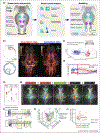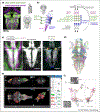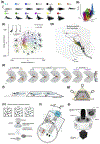Whole-brain interactions underlying zebrafish behavior
- PMID: 33221591
- PMCID: PMC10697041
- DOI: 10.1016/j.conb.2020.09.011
Whole-brain interactions underlying zebrafish behavior
Abstract
Detailed quantification of neural dynamics across the entire brain will be the key to genuinely understanding perception and behavior. With the recent developments in microscopy and biosensor engineering, the zebrafish has made a grand entrance in neuroscience as its small size and optical transparency enable imaging access to its entire brain at cellular and even subcellular resolution. However, until recently many neurobiological insights were largely correlational or provided little mechanistic insight into the brain-wide population dynamics generated by diverse types of neurons. Now with increasingly sophisticated behavioral, imaging, and causal intervention paradigms, zebrafish are revealing how entire vertebrate brains function. Here we review recent research that fulfills promises made by the early wave of technical advances. These studies reveal new features of brain-wide neural processing and the importance of integrative investigation and computational modelling. Moreover, we outline the future tools necessary for solving broader brain-scale circuit problems.
Copyright © 2020 Elsevier Ltd. All rights reserved.
Conflict of interest statement
Conflict of interest statement
Nothing to declare.
Figures



References
Publication types
MeSH terms
Grants and funding
LinkOut - more resources
Full Text Sources

